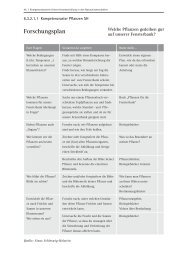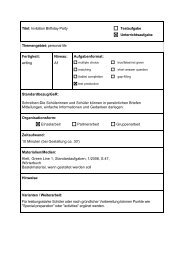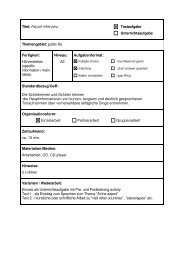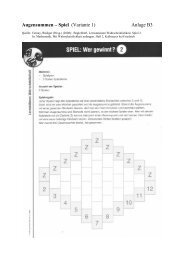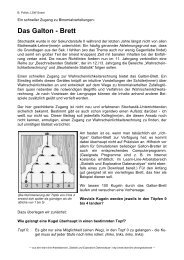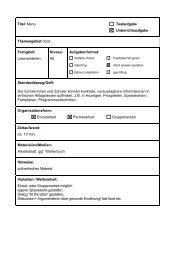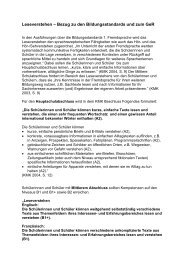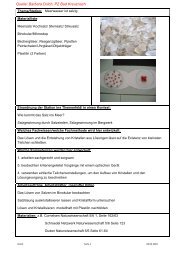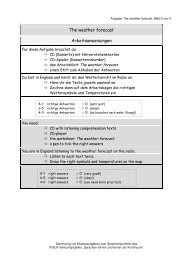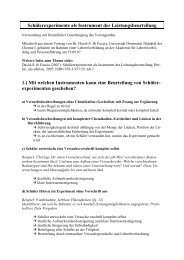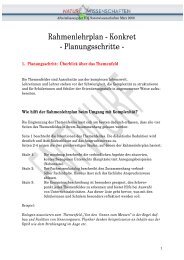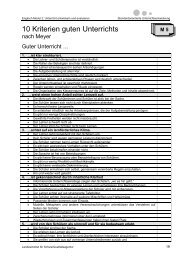Speaking - KMK-Projekt Format
Speaking - KMK-Projekt Format
Speaking - KMK-Projekt Format
You also want an ePaper? Increase the reach of your titles
YUMPU automatically turns print PDFs into web optimized ePapers that Google loves.
<strong>Speaking</strong><br />
Graham Hyatt<br />
Referent für f r Englisch<br />
Referat Qualitätssicherung<br />
Qualit tssicherung<br />
Ministerium für f r Bildung, Wissenschaft und Kultur, Mecklenburg-Vorpommern<br />
Mecklenburg Vorpommern<br />
based on a presentation by<br />
Dr. Rita Green<br />
Test Development Training & Analysis Ltd.<br />
www.testdevelopmenttrainingandanalysis.com
Outline<br />
• Characteristics and types of “<strong>Speaking</strong> <strong>Speaking</strong>”<br />
• What should our learners be able to do?<br />
– The “Standards Standards” and the CEF<br />
• What do we want to test and how?<br />
– Test specifications<br />
– Examples of good practice<br />
– What makes a good interlocutor<br />
– Writing tasks<br />
– Assessing candidate performance
• Why do we find relatively few speaking/oral<br />
tests/exams in Germany?<br />
time-consuming<br />
time consuming<br />
difficult to administer<br />
costly in terms of manpower<br />
not easy to set appropriate tasks<br />
problems of assessment – What? How?
Characteristics of <strong>Speaking</strong><br />
• Takes place in real time<br />
• We use different language in different situations<br />
– Some of it is planned<br />
– Some of it is unplanned/spontaneous<br />
– Formal versus colloquial<br />
• <strong>Speaking</strong> is a social and (usually ( usually) ) interactive<br />
process and skill<br />
<strong>Speaking</strong> is often dependent on listening
• Spoken language contains generic words e.g.<br />
“thing”, “thingy” etc.<br />
• Spoken language contains fillers e.g. “you<br />
know”, “you see”, “kind of”, “as it were” etc<br />
• it employs set phrases and expressions e.g “I<br />
thought you’d never ask”, “Let’s not go<br />
there”, “You must be joking”, …<br />
• The speaker needs to choose the appropriate<br />
language for a particular context
• Speakers hesitate, hesitate,<br />
add pauses<br />
• Speakers need time to process both input<br />
and output (speed speed depends on proficiency, proficiency,<br />
familiarity, familiarity,<br />
perceived accuracy requirements and<br />
penalties) penalties<br />
• “small small words/lubrications” words/lubrications are employed<br />
e.g. e.g.<br />
“really really”, , “oh oh”, , “well well”, , “I I mean”, mean , [Hasselgren [ Hasselgren, ,<br />
2004]“yes 2004] yes but …”<br />
• Scientific studies …<br />
“support support the case that the more small words a learner uses, the better better<br />
their perceived fluency” fluency (Luoma Luoma, , Assessing <strong>Speaking</strong>, page 19)
• Planned: Planned<br />
– the speaker has prepared and practised a speech or<br />
presentation (at home / before the test)<br />
– pronunciation and intonation have been<br />
practised<br />
– often tends towards formality of lexis and syntax<br />
• Unplanned<br />
– e.g. e.g.<br />
everyday conversation – spontaneous<br />
utterances; utterances;<br />
short sense units, units,<br />
incomplete sentences<br />
– pronunciation and intonation less controlled<br />
– lexis and syntax tend to be informal/colloquial
• Chatting<br />
Situations<br />
– Conversation,<br />
Conversation,<br />
small talk<br />
• purpose: purpose:<br />
to establish and maintain contact; contact<br />
• the atmosphere is friendly, friendly,<br />
tendency to agreement<br />
rather than argument<br />
• often found at the beginning of speaking tests i.e. i.e.<br />
the warm-up warm up (Should Should the warm-up warm up be assessed?) assessed?)
Situations (2)<br />
• Transmission / exchange of information on a particular<br />
topic / transactional<br />
– aim: aim:<br />
to communicate a specific piece of information or<br />
statement successfully i.e. i.e.<br />
so that the “message message” is<br />
understood<br />
– characteristics:<br />
characteristics:<br />
establishing a common basis of conversation,<br />
conversation,<br />
exchanging information in easily manageable and<br />
comprehensible “bites bites”; ; information is presented in a<br />
logical sequence; sequence;<br />
questions and answers, answers,<br />
repetition and<br />
checking whether the message has been understood
What we need to consider when<br />
developing speaking tasks/tests.(1):<br />
• The purpose of the test:<br />
– diagnostic (using using a test to determine the strengths and<br />
weaknesses of a test taker or test takers / establishing the<br />
level the test-taker test taker has reached to determine future needs) needs<br />
– assessing performance and awarding grades<br />
(classroom classroom situation / year 10 examination?)<br />
examination?)<br />
– placement (assigning assigning to particular courses, courses<br />
admission to university) university<br />
– proficiency (determining the level of a test taker against a<br />
descriptor of performance such as the CEFR)
What we need to consider when<br />
developing speaking tasks/tests.(2):<br />
• functions functions ((please please refer refer to to the the CEF): CEF):<br />
– expressing (thanks thanks, , advice, advice,<br />
opinions, opinions,<br />
information, information,<br />
apologies, apologies,<br />
wants/needs,<br />
wants/needs,<br />
complaints, complaints,<br />
attitudes, attitudes<br />
ideas, ideas,<br />
reasons, reasons,<br />
preferences) preferences<br />
– requesting (advice advice, , information, information,<br />
permission, permission,<br />
reasons) reasons<br />
– describing (people people, , places, places,<br />
objects) objects<br />
– comparing/contrasting (people people, , places, places,<br />
objects, objects,<br />
situations) situations<br />
– narrating (stories stories, , events)<br />
events
– agreeing/disagreeing<br />
– accepting / refusing<br />
– persuading, persuading,<br />
warning, warning,<br />
making suggestions<br />
– directing, directing,<br />
ordering, ordering,<br />
giving permission<br />
– analysing, analysing,<br />
criticising, criticising,<br />
predicting, predicting,<br />
arguing for/against,<br />
for/against,<br />
summarising
• Output<br />
The test taker should be able to:<br />
– describe a picture<br />
– give a presentation<br />
– make a speech<br />
– initiate / maintain a conversation<br />
– negotiate a conclusion<br />
– give detailed directions<br />
– provide an explanation<br />
– make an apology … [Banerjee Banerjee, , 2007]
CEFR<br />
• give a prepared talk and answer follow-up follow up<br />
questions<br />
• give straightforward descriptions, reasons and<br />
explanations on a variety of familiar subjects<br />
• give short justifications and explanations for<br />
views, plans or actions<br />
• give detailed accounts of experiences describing<br />
feelings and reactions<br />
• relate the plot of a book or film and describe<br />
his/her reactions<br />
• narrate a simple story or event
Factors which influence the test-<br />
taker’s taker performance<br />
• Knowledge of the language – level of<br />
competence<br />
• personal characteristics e.g. e.g.<br />
age, gender, gender,<br />
nationality, nationality,<br />
L1, education, education,<br />
preparation for<br />
and familiarity with the test situation and<br />
the test in general<br />
• general knowledge<br />
• emotional reaction to the task<br />
• interaction with other candidates (paired paired or group, group,<br />
known /<br />
unknown, unknown,<br />
gender, gender,<br />
level of proficiency of group members) members<br />
• interaction with the interlocutor
Examiner<br />
• Should there be one person who performs two<br />
roles (interlocutor interlocutor and assessor) assessor)<br />
or two people? people<br />
• Personal characteristics of the interlocutor: interlocutor:<br />
gender, gender,<br />
age, experience of testing, testing,<br />
accent, accent,<br />
speed of delivery, native v non-native non native<br />
speaker<br />
• Inter-action Inter action with the test-taker(s test taker(s): ):<br />
nature and scope – interlocutor frame
The tasks<br />
• level of difficulty /CEF level<br />
– uni-level uni level or multi-level multi level<br />
• task type: type:<br />
e.g. e.g.<br />
role-play role play, , interview,<br />
conversation,<br />
conversation,<br />
short presentation etc.<br />
• material/stimuli:<br />
material/stimuli:<br />
e.g. e.g.<br />
photographs,<br />
photographs,<br />
role-play role play cards, cards<br />
• length of the task<br />
preparation time<br />
speaking time
Tasks continued<br />
• number of tasks within a test?<br />
• instructions for the candidate and the<br />
examiner / interlocutor<br />
[Interlocutor Interlocutor Frame – essential for fairness<br />
and standardisation]<br />
standardisation<br />
• administration of the test:<br />
– planning, planning,<br />
organisation, organisation,<br />
blocking<br />
– will the test be recorded? recorded<br />
– preparation, preparation,<br />
supervision, supervision,<br />
invigilation … ?
Test Specifications<br />
and the<br />
Common European Framework
Assessment of <strong>Speaking</strong> Tasks/Tests<br />
Scales<br />
• Holistic scales = “express express an overall impression of an<br />
examinee’s examinee s ability in one score” score (Luoma Luoma, , pages 60/61)<br />
• Analytical scales = assess a number of different aspects of the<br />
canidate’s canidate performance e.g.<br />
– task fulfilment - content and communication<br />
– pronunciation<br />
– fluency<br />
– organisation (coherence/cohesion<br />
coherence/cohesion)<br />
– grammar – range and accuracy<br />
– vocabulary - range and accuracy<br />
– interaction - e.g. e.g.<br />
with the examiner/interlocutor, examiner/interlocutor,<br />
in pair or<br />
group tasks
<strong>Speaking</strong> Assessment Scales
Good Practice<br />
careful test development procedure: constantly<br />
revised test specifications<br />
strictly controlled item production procedure<br />
(revision and editing of tasks)<br />
piloting all tasks with students<br />
training item-writers item writers<br />
the use of item-writer item writer guidelines
Good Practice continued<br />
standardised tandardised examination procedure (the use of<br />
an Interlocutor Frame)<br />
examiner training focusing on both interlocutor<br />
& assessor training<br />
the use of benchmarked performances in<br />
examiner training
Bibliography and Sources<br />
• Csépes Cs pes, , I & Együd, Egy , G., Into Europe – Prepare for Modern<br />
English Exams, Exams,<br />
The <strong>Speaking</strong> Handbook, Handbook,<br />
British<br />
Council – Teleki Lászl L szló Foundation (2003)<br />
• Banerjee, Banerjee,<br />
J., Lancaster University, course Language<br />
Testing at Lancaster, Lancaster,<br />
2007<br />
• Green, R., PowerPoint Presentation, Presentation,<br />
Berlin, 2008<br />
• Hasselgren, Hasselgren,<br />
A., Testing the Spoken English of Young<br />
Norwegians, Norwegians,<br />
CUP (2004)<br />
• Luoma, Luoma,<br />
S., Assessing <strong>Speaking</strong>, <strong>Speaking</strong>,<br />
CUP (2004)<br />
• Schuh-Fricke<br />
Schuh Fricke, , U., PowerPoint Presentation,<br />
Presentation,<br />
Braunschweig, 2008
INTO EUROPE<br />
Series Editor: J. Charles Alderson<br />
The The <strong>Speaking</strong> <strong>Speaking</strong> Handbook Handbook<br />
Ildikó Ildik Csépes Cs pes & Györgyi Gy rgyi Együd Egy<br />
The Handbook is accompanied by a 5-hour 5 hour DVD<br />
Published by Teleki Lászl szló Foundation<br />
& The British Council<br />
Distributor: Libro Trade<br />
Info: books@librotrade.hu<br />
The Into Europe series can now be downloaded from<br />
http://www.lancs.ac.uk/fass/projects/examreform/




